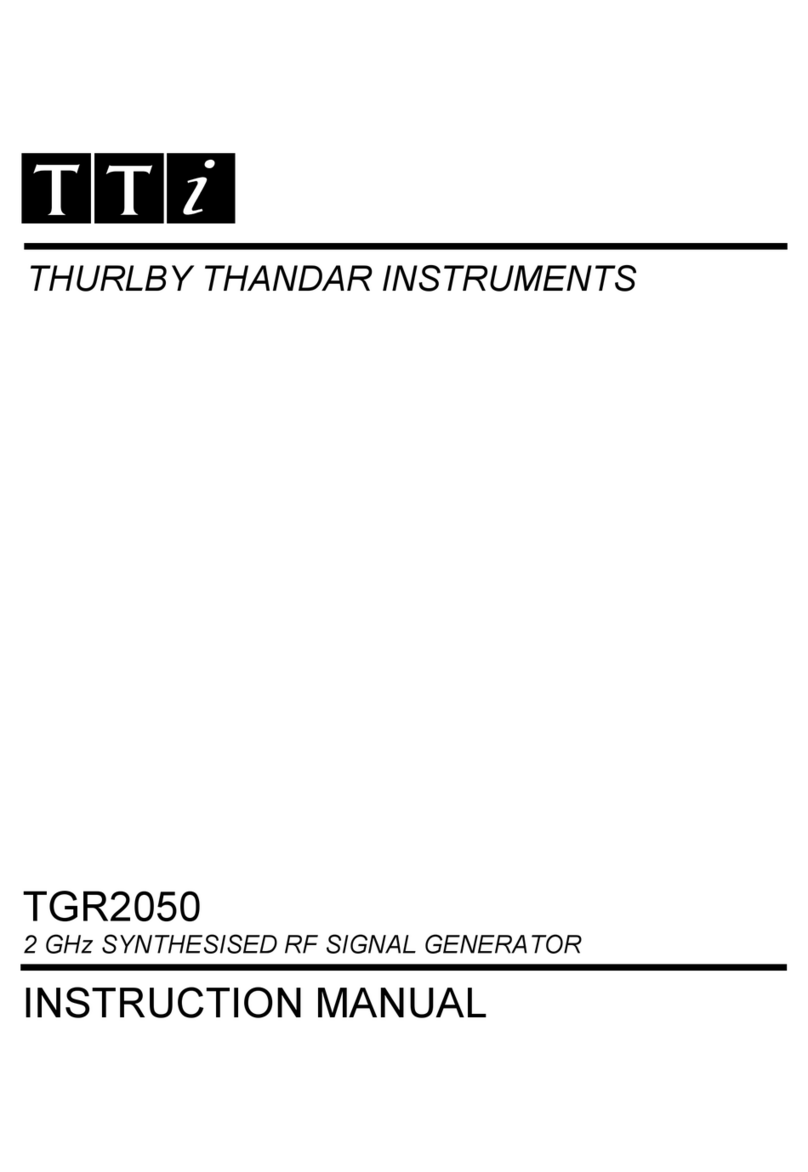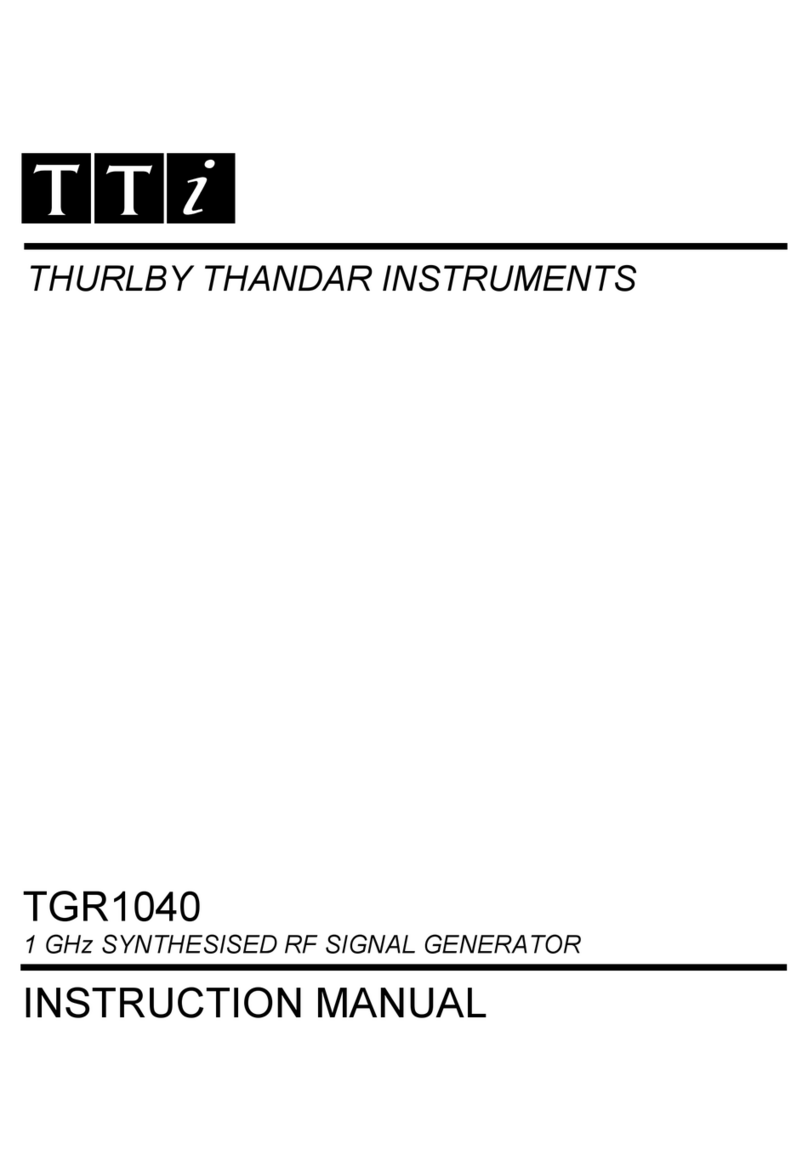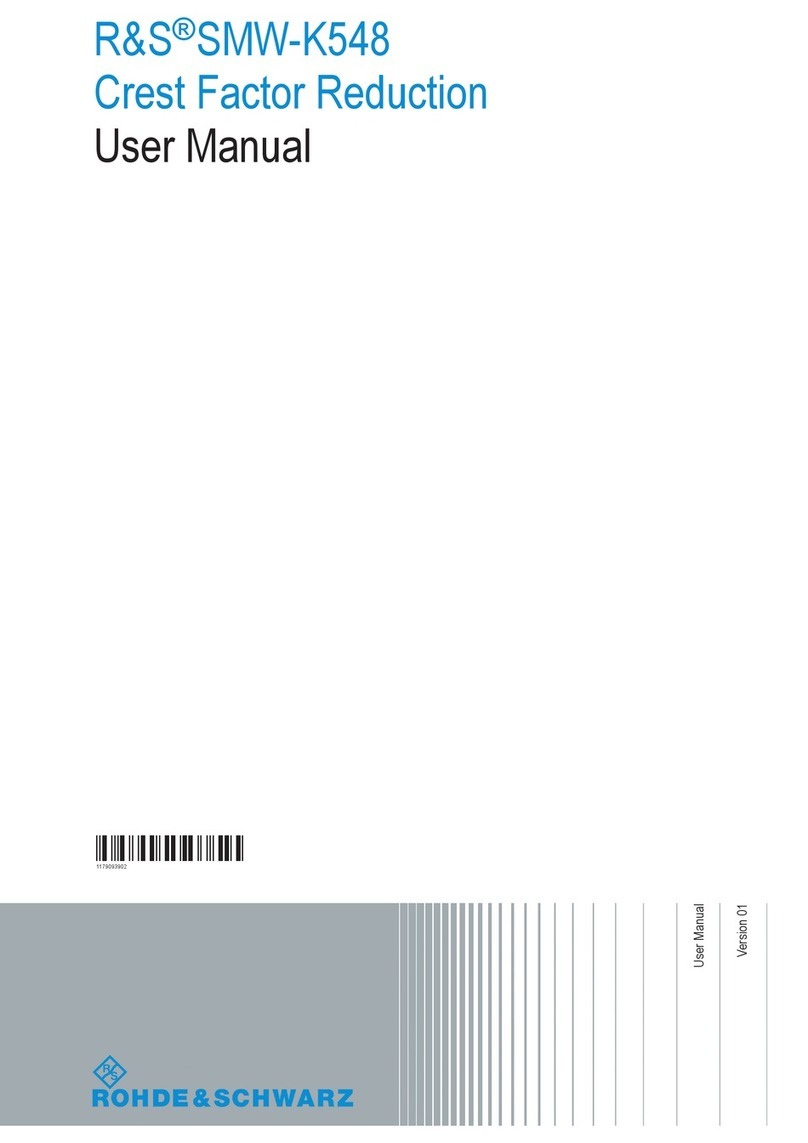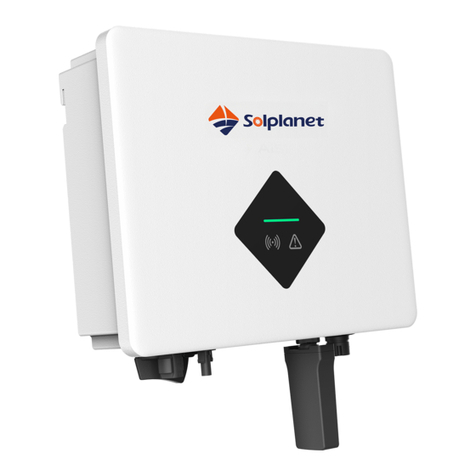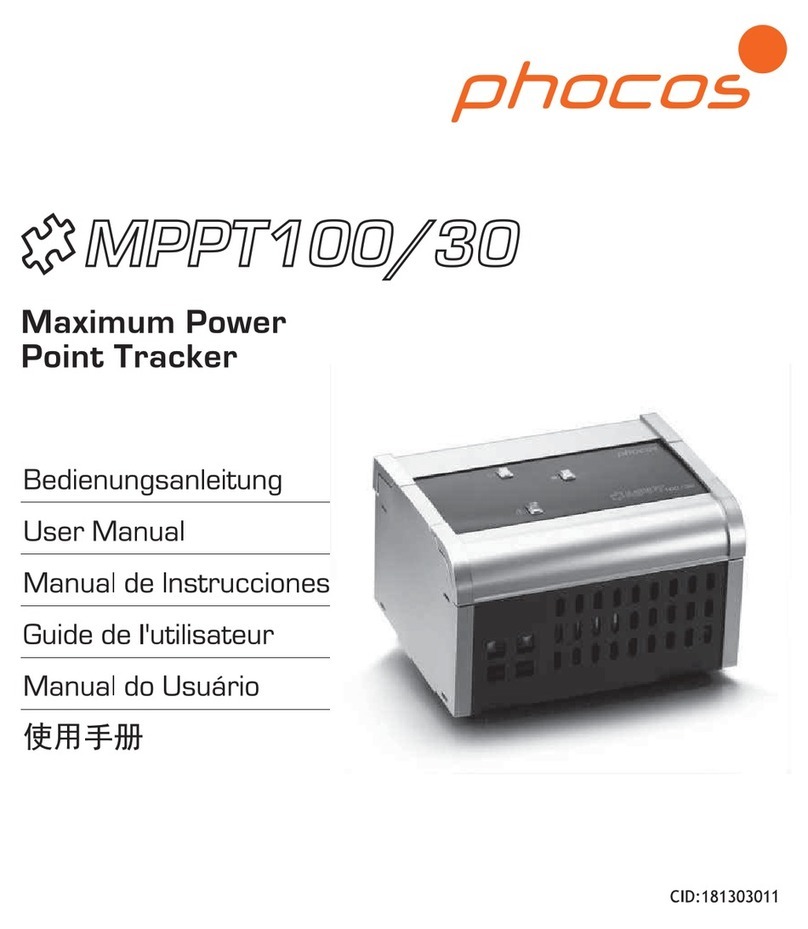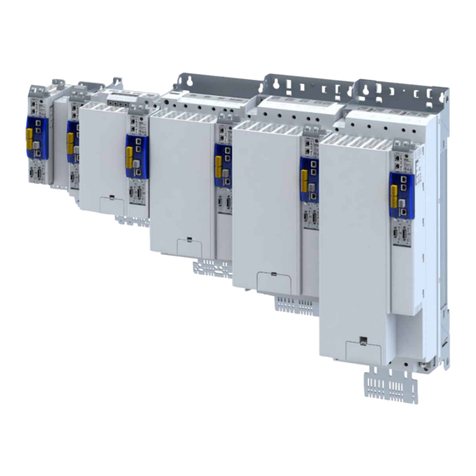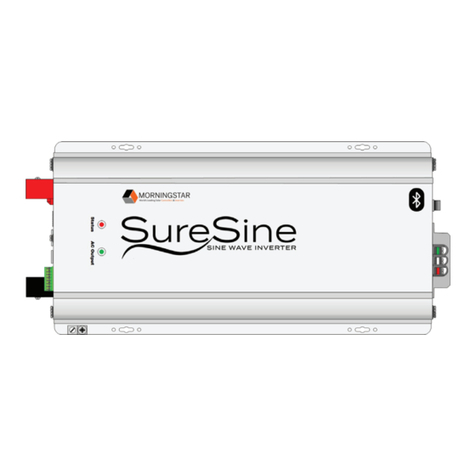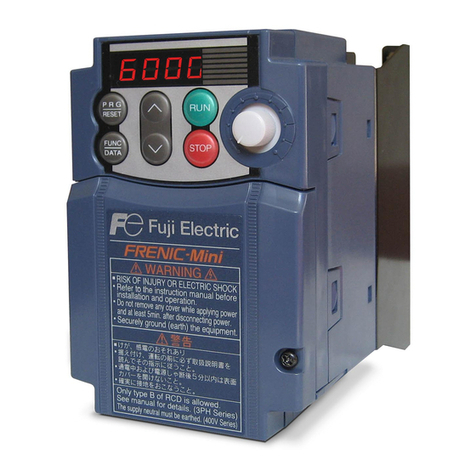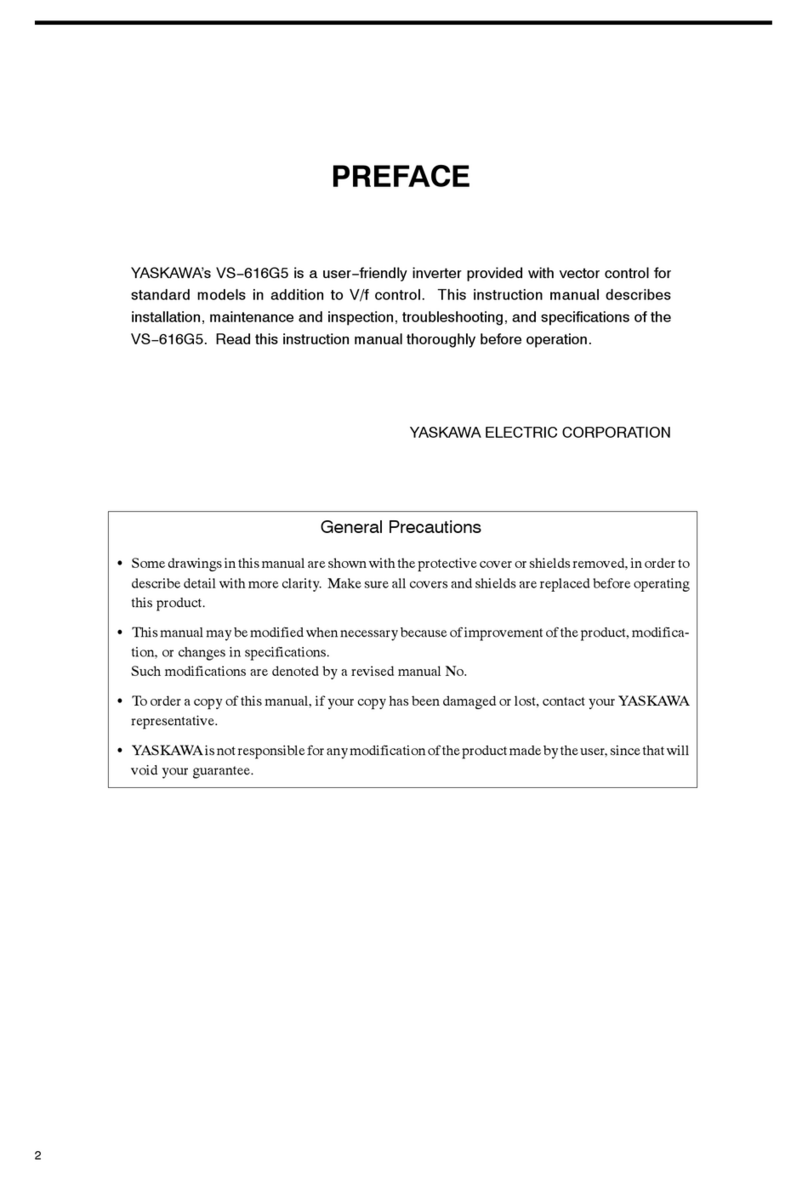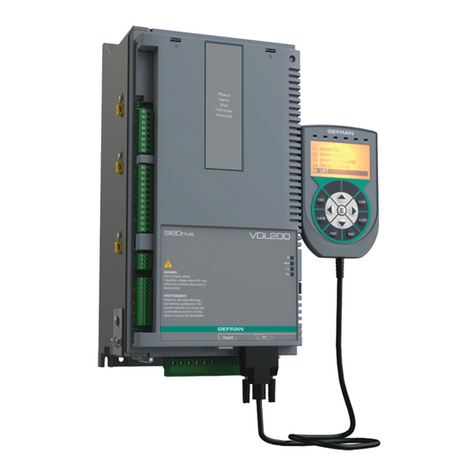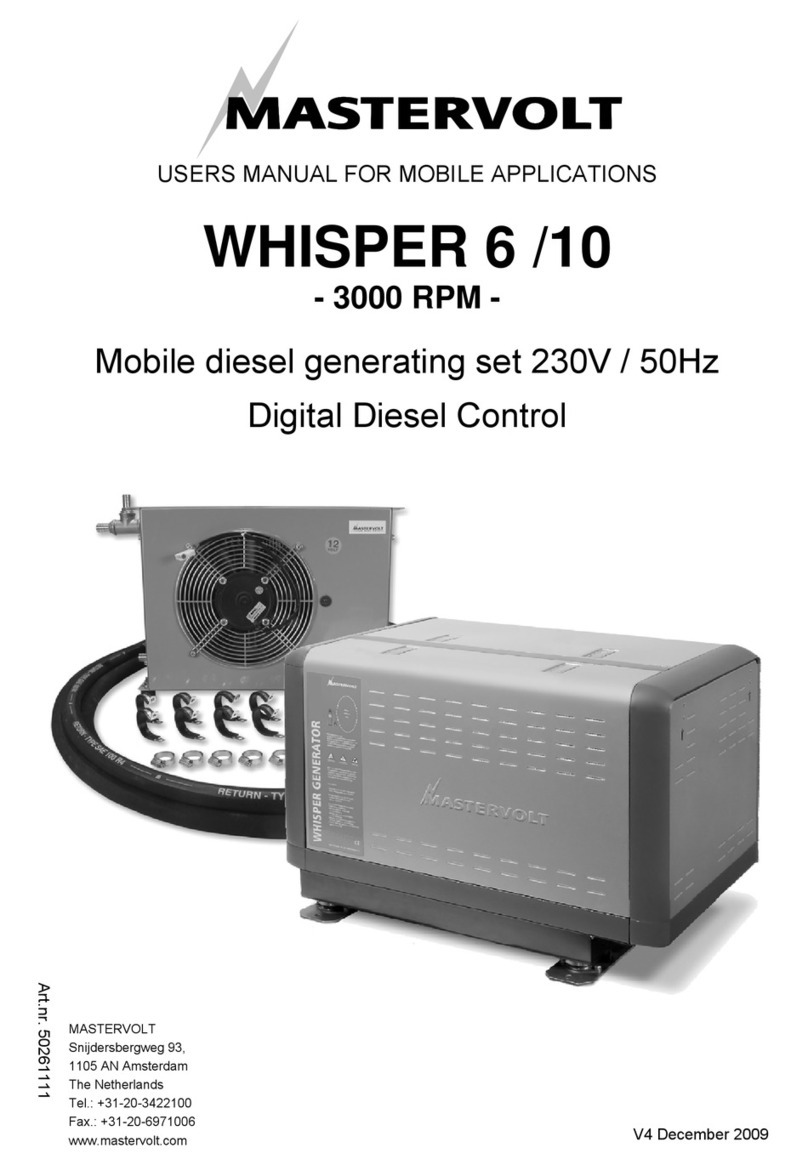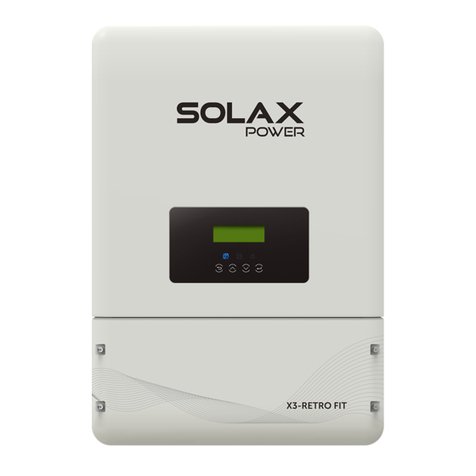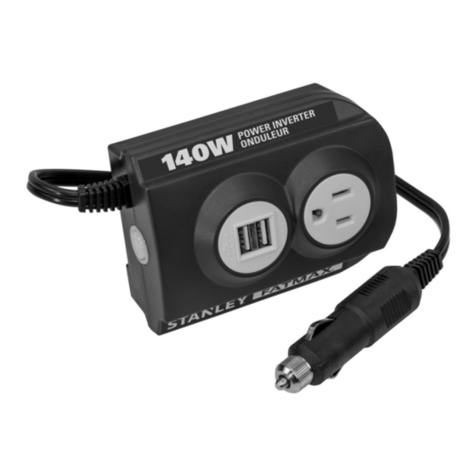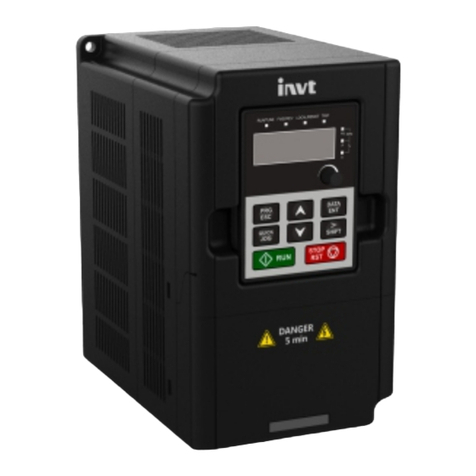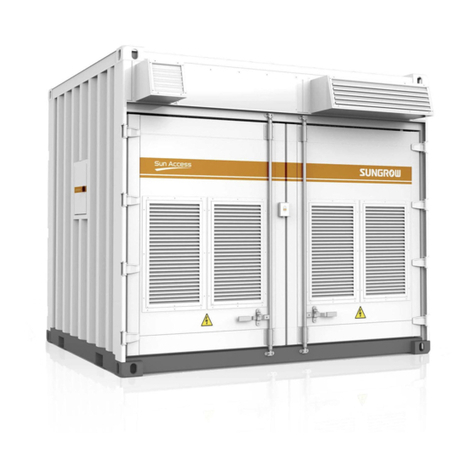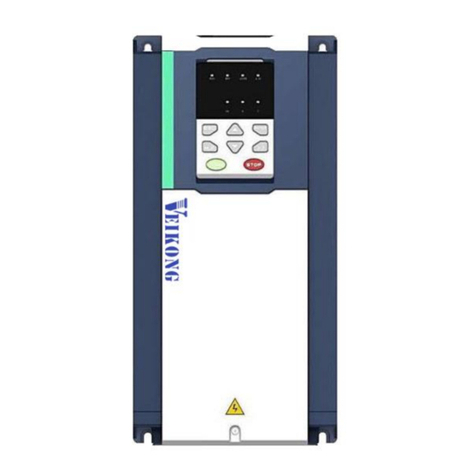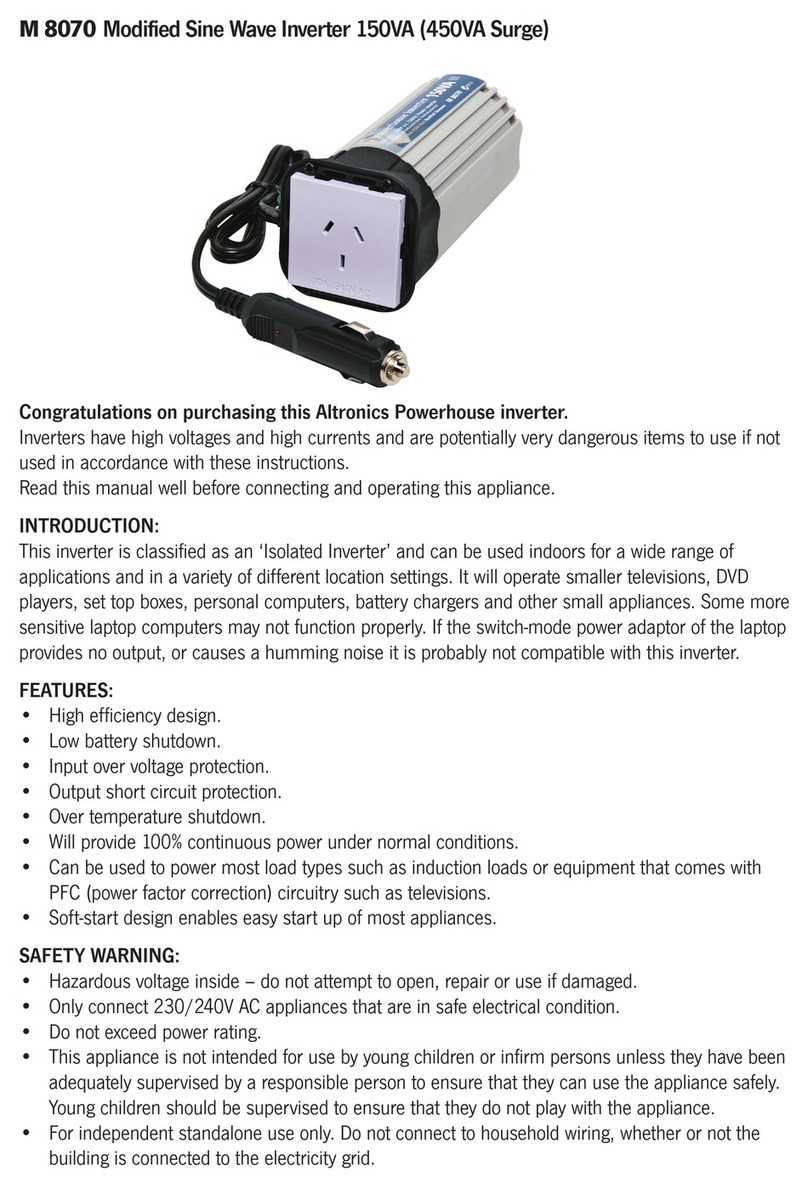Thurlby Thandar Instruments TG300 Series User manual

THURLBY THANDAR INSTRUMENTS
INSTRUCTION MANUAL
TG300 Series
3MHz Function Generators

Table of Contents
Introduction 2
Specification 3
EMC 7
Safety 8
Installation 9
Operation 10
Calibration and Maintenance 13
Instructions en Francais
Sécurité 14
Installation 15
Fonctionnement 16
Calibrage et maintenance 20
Bedienungsanleitung auf Deutsch
Sicherheit 21
Installation 22
Betrieb 23
Kalibrierung und Wartung 27
Istruzioni in Italiano
Sicurezza 28
Installazione 29
Funzionamento 30
Calibrazione e Manutenzione 34
Instrucciones en Español
Seguridad 35
Instalación 36
Funcionamiento 37
Calibrado y Mantenimiento 41
1

Introduction
The TG300 series are precision 3MHz function generators with waveforms of sine, triangle, ramp.
pulse and DC from a variable amplitude 50Ωor 600Ωoutput. A TTL/CMOS auxiliary output is also
provided.
The frequency range is 0·03Hz to 3MHz selected by a seven decade range multiplier and
calibrated vernier. Both the frequency vernier and the sweep input can give 1000:1 frequency
change within a selected range. A 10:1 symmetry range permits ramp and pulse waveforms to be
produced.
The generator output level is 20Vpk-pk maximum from a 50/600Ωsource. The level is set via a
switched attenuator plus vernier with a total range of >80dB. DC offset is vernier adjustable over
a ±10V range with centre detent for 0V. Waveform quality is good at all frequencies and signal
levels.
All models feature a large liquid crystal display shows frequency and amplitude simultaneously.
Good resolution and a fast display update rate are maintained at all frequencies.
The TG330 also has internal LIN/LOG sweep with sweep output and AM. Amplitude modulation of
up to 100% is possible using the internal 400Hz oscillator or an external source.
On the TG320 and TG330 the display can also be used as an external 120MHz frequency meter
with up to 7-digit resolution.
Additional display annunciators indicate generator status when sweep, AM, etc. are in use.
2

Specification
Specifications apply at 18º - 28º after one hour warm-up, at maximum output into 50Ω.
FREQUENCY
Frequency Range: 0·03Hz to 3MHz in 7 overlapping decade ranges with adjustment by vernier
control.
Vernier Range: 1000:1 on each range.
Frequency Display: Auto-ranging reciprocal measurement giving 4-digit resolution down to 10Hz
(to 1Hz on the 3Hz range); resolution is fixed at 0·01Hz below 10Hz
(0·001Hz below 1Hz on the 3Hz range).
Accuracy is ±1 digit to 2·1Hz (to 0·21Hz, Symmetry off, or to 0·42Hz,
Symmetry on, on the 3Hz range); below this the accuracy is ± 1% of range
full scale (unspecified with Symmetry on).
WAVEFORMS
Waveform specifications apply for the top decade of each frequency range.
SINE
Distortion: Less than 0·5% on 300Hz, 3kHz and 30kHz ranges; less than 1% on 3Hz,
30Hz and 300kHz ranges; all harmonics >25dB below fundamental on
3MHz range.
Amplitude Flatness: ± 0·2dB to 200kHz; ± 2dB to 3MHz.
TRIANGLE
Linearity: Better than 99% to 200kHz.
SQUAREWAVE
Rise and Fall Times: <100ns
Mark-Space Ratio: 1:1 ±1% to 100kHz
DC
Range: ±10V (unterminated).
SYMMETRY
Symmetry Range: Variable typically between 1:9 and 9:1 (on top decade of each range),
frequency divided by 10 when Symmetry is selected.
MODULATION MODES
Modulation can be used with all waveforms and at any frequency.
Sweep
Sweep Mode: Internal (TG330 only): linear or logarithmic; sweep Start and Stop
frequencies displayed at a press of a button.
External: linear.
Sweep Width: Up to 1000:1 within each range.
Sweep Rate: Internal sweep rate adjustable from typically 20ms to 20s.
External Sweep: By signal applied by SWEEP IN/OUT socket.
3

Amplitude Modulation (TG330 only)
Modulation Depth: Variable 0 to 100% typical.
Modulation Frequency: 400Hz internal. DC to 20kHz external.
External Modulation: By signal applied to COUNT/AM IN socket.
OUTPUTS
50ΩMain Out
Output Impedance: 50Ω
Amplitude: 2mV to 20V peak-peak open circuit (1mV to 10V peak-peak into 50Ω) in
four switch-selectable ranges with 20dB vernier control within each
range.
Attenuator: 0, –20, –40 or –60dB.
DC Offset Range: ±10V. DC offset plus signal peak limited to ±10V (± 5V into 50Ω); CLIP
shows in display when offset + signal peak exceeds ±10V. DC offset
plus waveform attenuated proportionally by the attenuator.
600ΩMain Out
Alternative output socket providing the same signal as the 50ΩMain Out but from 600Ω. The 50Ω
and 600Ωsockets are not independent.
Aux Out
Output Characteristics: Frequency, symmetry and phase the same as main outputs.
Output Level: 0 to 5V TTL/CMOS logic levels capable of driving 2 standard TTL loads.
Sweep Out (TG330 only)
When internal sweep is selected the sweep signal is available as a 0 to 3V ramp from 600Ω.
INPUTS
Sweep In
The SWEEP IN/OUT socket is set to Sweep In when EXT SWEEP is selected.
Input Impedance: 10kΩ
Input Sensitivity: 0 to 3V for 1000:1 sweep.
Maximum Allowable
Input Voltage:
±10V
Sweep Linearity: Better than 1%
Maximum Slew Rate of
Sweep Voltage:
0·1V/µs
AM In (TG330 only)
The AM/COUNT IN socket is set to AM input when EXT AM is selected.
Input Impedance: 40kΩ
Input Sensitivity: Approximately 2V peak-peak for 100% modulation.
Maximum Allowable
Input Voltage:
±10V
4

Count In (TG330/TG320)
The AM/COUNT IN socket is set to external frequency measurement when EXT COUNT is
selected.
Input Impedance: 1MΩ//25pF
Input Sensitivity: 50mVrms (sinewave).
Maximum Allowable
Input Voltage: 50Vdc/50Vrms to 400Hz with respect to ground , reducing to 1Vrms
above 1MHz.
DISPLAY FUNCTIONS
The LCD shows generator frequency simultaneously with output amplitude/offset, together with
various status annunciators. Alternatively, it is the external frequency measurement display.
Internal Measurement Accuracy
Frequency: Auto-ranging reciprocal measurement giving 4-digit resolution down to
10Hz (to 1Hz on the 3Hz range); resolution is fixed at 0·01Hz below 10Hz
(0·001Hz below 1Hz on the 3Hz range).
Accuracy is ±1 digit to 2·1Hz (to 0·21Hz, Symmetry off, or to 0·42Hz,
Symmetry on, on the 3Hz range); below this the accuracy is ±1% of range
full scale (unspecified with Symmetry on).
Amplitude: Display shows peak-to-peak amplitude or rms value. Display corrected for
attenuator setting. 3-digit resolution, accuracy typically ± 5% of range full
scale.
DC Offset: 3-digit resolution; accuracy typically ± 2% setting ±1 digit.
Display corrected for attenuator setting.
External Frequency Measurement (TG330 & TG320)
Frequency Range: 5Hz to >20MHz and <20MHz to >120MHz in 2 switchable ranges.
Input Sensitivity: 50mVrms (sinewave).
Measurement Time: Selectable 0·5s or 5s.
Resolution: 6 digits in 0·5s; 7 digits in 5s.
Accuracy: ±1 digit ± timebase accuracy.
Timebase Accuracy: ±10ppm initial error; ± 5 ppm/year ageing rate; typically less than
0·5 ppm/ºC.
GENERAL
POWER REQUIREMENTS
AC Input Voltage: 220V AC-240V AC or 110V AC-120V AC ±10%, 50/60Hz, by internal
adjustment. Installation Category II.
Power Consumption: 25VA max.
Operating Range: + 5°C to + 40°C, 20% to 80% RH.
Storage Range: –10°C to + 65°C
Environmental: Indoor use at altitudes up to 2000m, Pollution Degree 2.
Size: 260(W) x 88(H) x 235(D)mm (10.2 x 3.4 x 9.2") excluding handle and feet.
Weight: 1.9kg (4.2lb).
Safety: Complies with EN61010-1.
EMC: Complies with EN61326.
5

EC Declaration of Conformity
We Thurlby Thandar Instruments Ltd
Glebe Road
Huntingdon
Cambridgeshire PE29 7DR
England
declare that the
TG315, TG320 and TG330 3MHz Function Generators
meet the intent of the EMC Directive 2004/108/EC and the Low Voltage Directive 2006/95/EC.
Compliance was demonstrated by conformance to the following specifications which have been
listed in the Official Journal of the European Communities.
EMC
Emissions: a) EN61326-1 (2006) Radiated, Class B
b) EN61326-1 (2006) Conducted, Class B
c) EN61326-1 (2006) Harmonics, referring to EN61000-3-2 (2006)
Immunity: EN61326-1 (2006) Immunity Table 1, referring to:
a) EN61000-4-2 (1995) Electrostatic Discharge
b) EN61000-4-3 (2006) Electromagnetic Field
c) EN61000-4-11 (2004) Voltage Interrupt
d) EN61000-4-4 (2004) Fast Transient
e) EN61000-4-5 (2006) Surge
f) EN61000-4-6 (2007) Conducted RF
Performance levels achieved are detailed in the user manual.
Safety
EN61010-1 Installation Category II, Pollution Degree 2.
CHRIS WILDING
TECHNICAL DIRECTOR
1 May 2009
6

EMC
This instrument has been designed to meet the requirements of the EMC Directive 2004/108/EC.
Compliance was demonstrated by meeting the test limits of the following standards:
Emissions
EN61326-1 (2006) EMC product standard for Electrical Equipment for Measurement, Control and
Laboratory Use. Test limits used were:
a) Radiated: Class B
b) Conducted: Class B
c) Harmonics: EN61000-3-2 (2006) Class A; the instrument is Class A by product category.
Immunity
EN61326-1 (2006) EMC product standard for Electrical Equipment for Measurement, Control and
Laboratory Use.
Test methods, limits and performance achieved are shown below (requirement shown in
brackets):
a) EN61000-4-2 (1995) Electrostatic Discharge : 4kV air, 4kV contact, Performance A (B).
b) EN61000-4-3 (2006) Electromagnetic Field:
3V/m, 80% AM at 1kHz, 80MHz – 1GHz: Performance A (A) and 1.4GHz to 2GHz:
Performance A (A); 1V/m, 2.0GHz to 2.7GHz: Performance A (A).
c) EN61000-4-11 (2004) Voltage Interrupt: ½ cycle and 1 cycle, 0%: Performance A (B);
25 cycles, 70% and 250 cycles, 0%: Performance B (C).
d) EN61000-4-4 (2004) Fast Transient, 1kV peak (AC line), 0·5kV peak (signal connections),
Performance A (B).
e) EN61000-4-5 (2006) Surge, 0·5kV (line to line), 1kV (line to ground), Performance A (B).
f) EN61000-4-6 (2007) Conducted RF, 3V, 80% AM at 1kHz (AC line only; signal
connections <3m, therefore not tested), Performance A (A).
According to EN61326-1 the definitions of performance criteria are:
Performance criterion A: ‘During test normal performance within the specification limits.’
Performance criterion B: ‘During test, temporary degradation, or loss of function or
performance which is self-recovering’.
Performance criterion C: ‘During test, temporary degradation, or loss of function or
performance which requires operator intervention or system reset occurs.’
Cautions
To ensure continued compliance with the EMC directive observe the following precautions:
a) Connect the generator to other equipment using only high quality, double−screened cables.
b) After opening the case for any reason ensure that all signal and ground connections are
remade correctly.
c) In the event of part replacement becoming necessary, only use components of an identical
type, see the Service Manual.
7

Safety
This instrument is Safety Class I according to IEC classification and has been designed to meet
the requirements of EN61010-1 (Safety Requirements for Electrical Equipment for Measurement,
Control and Laboratory Use). It is an Installation Category II instrument intended for operation
from a normal single phase supply.
This instrument has been tested in accordance with EN61010-1 and has been supplied in a safe
condition. This instruction manual contains some information and warnings which have to be
followed by the user to ensure safe operation and to retain the instrument in a safe condition.
This instrument has been designed for indoor use in a Pollution Degree 2 environment in the
temperature range 5°C to 40°C, 20% - 80% RH (non-condensing). It may occasionally be
subjected to temperatures between +5°C and –10°C without degradation of its safety. Do not
operate while condensation is present.
Use of this instrument in a manner not specified by these instructions may impair the safety
protection provided. Do not operate the instrument outside its rated supply voltages or
environmental range.
WARNING! THIS INSTRUMENT MUST BE EARTHED
Any interruption of the mains earth conductor inside or outside the instrument will make the
instrument dangerous. Intentional interruption is prohibited. The protective action must not be
negated by the use of an extension cord without a protective conductor.
When the instrument is connected to its supply, terminals may be live and opening the covers or
removal of parts (except those to which access can be gained by hand) is likely to expose live
parts. The apparatus shall be disconnected from all voltage sources before it is opened for any
adjustment, replacement, maintenance or repair.
Any adjustment, maintenance and repair of the opened instrument under voltage shall be avoided
as far as possible and, if inevitable, shall be carried out only by a skilled person who is aware of
the hazard involved.
If the instrument is clearly defective, has been subject to mechanical damage, excessive moisture
or chemical corrosion the safety protection may be impaired and the apparatus should be
withdrawn from use and returned for checking and repair.
Make sure that only fuses with the required rated current and of the specified type are used for
replacement. The use of makeshift fuses and the short-circuiting of fuse holders is prohibited.
Do not wet the instrument when cleaning it.
The following symbols are used on the instrument and in this manual:-
Caution - refer to the accompanying documentation, incorrect operation
may damage the instrument.
terminal connected to chassis ground.
alternating current.
8

Installation
Mains Operating Voltage
The operating voltage of the instrument is shown on the rear panel. Should it be necessary to
change the operating voltage from 230V to 115V or vice-versa, proceed as follows:
1. Disconnect the instrument from all voltage sources.
2. Unclip the front bezel by gently pulling the centre of each long edge up and forward.
The case halves are held together by 4 plastic push-rivets. Use the blade of a small
screwdriver in the slot beside each rivet to first ease out the rivet head and then fully
remove the rivet body. Separate the case halves. Visit www.tti-test.com for further
details.
3. Remove the 6 screws securing the main pcb to the case upper and lift the pcb free,
complete with front and rear panels.
4. Change the appropriate zero-ohm links beside the transformer on the pcb:
Link LK2 only for 230V operation
Link LK1 and LK3 only for 115V operation
5. Refit the pcb to the case upper, ensuring all connections (especially safety earth) are
remade as before, and refit the case lower.
6. To comply with safety standard requirements the operating voltage marked on the rear
panel must be changed to clearly show the new voltage setting.
7. Change the fuse to suit the new operating voltage, see below.
Fuse
The correct time-lag fuse must be fitted for the selected operating voltage.
For 230V operation use 125mA (T) 250V HBC.
For 115V operation use 250mA (T) 250V HBC.
Make sure that only fuses with the required rated current and of the specified type are used for
replacement. The use of makeshift fuses and the short-circuiting of fuse holders are prohibited.
Mains Lead
When a three core mains lead with bare ends is provided it should be connected as follows:
Brown - Mains live
Blue - Mains Neutral
Green/Yellow - Earth
WARNING! THIS INSTRUMENT MUST BE EARTHED
Any interruption of the mains earth conductor inside or outside the instrument will make the
instrument dangerous. Intentional interruption is prohibited.
9

Operation
Switching On
Switch on the generator using the ON/OFF switch on the rear panel. To fully disconnect from the
AC supply unplug the mains cord from the back of the instrument or switch off at the AC supply
outlet; make sure that the means of disconnection is readily accessible. Disconnect from the AC
supply when not in use.
TG330/TG320: Ensure that the push-button switches in the SWEEP and AMPLITUDE
MODULATION/EXT COUNTER sections of the control panel are all set to the position,
i.e. set the generator to its normal, unmodulated, running mode. The display will show the
frequency and peak-to-peak output amplitude with appropriate range annunciators.
Frequency Setting
Frequency is set by pressing the appropriate FREQUENCY RANGE push button and rotating the
calibrated FREQUENCY vernier. The vernier controls provide a 1000:1 frequency change within
each range. The auto-ranging meter makes reciprocal frequency measurements down to 2·1Hz
(to 0·21Hz on the 3Hz range); the display update rate in this mode is 130ms or 1 waveform
period, whichever is the longer. Below these frequencies a fast measurement update rate is
maintained by changing the measurement method but accuracy is reduced, see Specification.
When SYMMETRY is switched ON the SYMMETRY control can be used to vary the duty cycle
from 1:10 to 10:1 to produce sawtooth and variable pulse-width waveforms. Optimum
performance of the SYMMETRY control is achieved on the top decade of each frequency range.
When SYMMETRY is selected SYM shows in the display and the generator frequency is divided
by 10; the display shows the correct frequency. The changeover in frequency measurement
method now happens at 0·21Hz on the 30Hz range and 0·42Hz on the 3Hz range.
Waveform
The output waveform shape is selected by depressing one of the three function buttons to give
sine, square or triangle. With all three switches out (accomplished by half-depressing any one)
the output will be a DC level only; this is useful as it permits input threshold testing of a circuit
without having to connect up an external DC supply.
Amplitude
The amplitude of the MAIN OUT outputs is set by the AMPLITUDE control and the ATTENUATOR
switches. Maximum output is 20 volts peak-to-peak open-circuit, 10 volts
peak-to-peak when terminated with the outputs characteristic impedance.
The AMPLITUDE control has greater than 20dB range; the ATTENUATOR switches permit
selection of up to -60dB attenuation (both switches pressed together). Used together these
controls provide a range of 20V peak-to-peak down to 2mV peak-to-peak, or 10V peak-to-peak
down to 1mV peak-to-peak into the output’s characteristic impedance.
Still greater attenuation of the 50ΩMAIN OUT can be achieved by using standard 50ΩBNC
attenuators. To maintain waveform integrity only 50Ωcable should be used and the receiving end
should be terminated with a 50Ωload.
The MAIN OUT outputs will withstand a short circuit for a period of 10 minutes at maximum output
and greater periods at lower output levels. However, damage will occur if an external voltage is
connected to the output sockets.
The 50Ωand 600Ωoutputs are not independent; terminating one will affect the amplitude of the
other.
The amplitude is displayed on the right-hand side of the LCD; pressing the PK-PK/RMS button
beside the display will alternate the reading between peak-to-peak volts (Vp-p) and r.m.s. volts
(Vrms). The readout is correctly adjusted for attenuator setting and waveform shape.
The display shows open circuit voltage; the actual voltage at the socket will be half the displayed
value when the output is terminated with its characteristic impedance.
10

DC Offset
The DC OFFSET control has a range of ±10 volts from 50Ω/600Ωin all output modes; the control
has a centre detent for 0 volts. DC offset plus signal peak is limited to ±10V (±5V into the
characteristic output impedance); CLIP shows in the display when this limit is exceeded.
DC offset plus waveform is attenuated proportionally by the ATTENUATOR switches.
The DC offset can be displayed in place of the output amplitude by pressing the OFFSET button
beside the display. The display shows open circuit voltage offset; the actual voltage at the socket
will be half the displayed value when the output is terminated with its characteristic impedance.
Auxiliary Output
The AUX OUT output provides a fixed 0 to 5V TTL/CMOS pulse output at the same frequency,
symmetry and phase as the MAIN OUT outputs and is capable of driving 2 standard TTL loads.
Internal Sweep (TG330 only)
With INT SWEEP selected the output of the internal sweep generator is summed with the
FREQUENCY vernier. Select LIN or LOG sweep mode; the annunciators LIN-SWP or SWP-LOG
will show in the display accordingly.
Frequency Selection
Using the FREQUENCY RANGE switches select the lowest range within which the upper sweep
limit can be set; in this way the best setting resolution and the widest sweep range can be
realised.
Sweep Limits
Turn the STOP control to minimum (fully-anticlockwise). Hold the SET START button and set the
START (lowest) frequency on the display using the FREQUENCY vernier; the START frequency
must be set first. Now release the SET START button, hold in the SET STOP button and set the
STOP (highest) frequency on the display using the STOP control; release the SET STOP button.
Note that both the FREQUENCY vernier and the STOP control have a log characteristic when
LOG mode is selected.
The sweep limits can be checked at any time by depressing the SET START or SET STOP.
Sweep Rate
The generator sweeps both up and down at the speed set by the RATE control, i.e. it does not
reset rapidly after the upward sweep. This has the advantage that the suitability of the selected
sweep time can be continuously monitored.
Sweep Out
When INT SWEEP is selected the SWEEP IN/OUT socket becomes an output providing a 0V to
3V ramp from 600Ωimpedance to drive the X-input of an oscilloscope or chart recorder.
Terminating this output with a resistor will reduce the output amplitude. Terminating with 600Ωwill
halve the output giving 0V to 3V.
Holding in the SET STOP button holds the ramp at the maximum and can therefore be used to
set full scale on the oscilloscope or chart recorder.
Note that when SWEEP IN/OUT is used as an output to drive the X-input of an oscilloscope, the
oscilloscope should be set to DC coupling and not AC coupling which will cause a double image
at slow sweep speeds.
11

External Sweep
TG330: When EXT SWEEP is selected the SWEEP IN/OUT socket becomes an input.
TG320/TG315: The SWEEP IN socket is the external sweep control input.
The generator frequency can be swept, DC programmed or modulated by a suitable control
voltage applied to this input. The instrument sums the SWEEP IN voltage with the internal control
voltage derived from the FREQUENCY vernier to determine the operating frequency; the display
shows the resultant frequency.
A positive voltage increases the frequency; for frequency control with positive-going DC inputs the
vernier should therefore be set to the lower frequency limit of the range to be swept. For example,
a 0V to +3V signal will sweep the generator 3 decades up from range minimum, set by the
vernier, to range maximum.
Similarly, a negative voltage decreases the frequency and for negative-going DC inputs the
vernier should be set to the upper frequency limit of the range to be swept. For example, a 0V to -
3V signal will sweep the generator 3 decades down from range maximum, set by the vernier, to
range minimum.
To use a sweep signal which is symmetrical about ground, the vernier should be set to give a
frequency at approximately the centre of the band to be swept.
In external sweep mode the LIN/LOG selection is inoperative, i.e. the FREQUENCY vernier is
always operating linearly, as marked.
Note: Non-linear operation may result when the sweep input voltage is excessive; that is, when
the attempted generator frequency exceeds the range limits.
Amplitude Modulation (TG330 only)
Depressing the AM ON/OFF button selects AM. The depth of modulation can be adjusted over a
0% to 100% range using the modulation DEPTH control. When AM is selected the output
amplitude will drop to 50% at 0% modulation.
With the AM INT/EXT button in the INT (internal) position, the modulation source is an internal
400Hz sinewave oscillator. The INT-AM annunciator is displayed.
With the AM INT/EXT button in the EXT (external) position, and the EXT COUNTER ON/OFF
button in the OFF EXT AM position, external AM modulation is possible via the AM/COUNT IN
socket; the AM-EXT annunciator is displayed. The modulating signal applied should have no DC
offset or should be AC coupled. A 2V peak-to-peak signal gives approximately 100% modulation
with the modulation control at maximum. Modulating the generator with a squarewave gives step
changes in the output amplitude which are suitable for testing signal compressors and automatic
gain controlled circuits.
Applying a DC offset of approximately -1V gives suppressed carrier modulation. The DC offset
should first be adjusted to suppress the carrier, and the modulating signal then applied.
Applying a DC offset greater than -1V will invert the MAIN OUT outputs with respect to AUX OUT.
The generator can also be asynchronously gated on and off using the AM facility. Select EXT AM
and apply a suitably offset squarewave to the AM/COUNT IN input. The squarewave Vlow should
be approximately -1V to give carrier suppression and the Vhigh should be +3V to +4V to give
normal full output.
12

External Counter (TG330 & TG320)
Selecting EXT COUNTER ON sets the COUNT IN socket to external frequency measurement.
The display changes to show a 6-digit frequency measurement and annunciators EXT and 0·5s
show in the display to indicate external measurement and a 0·5s gate time. Alternate presses of
the GATE TIME button beside the display selects between 0·5s and 5s gate time; measurement
resolution is 7-digit with 5s gate time.
In external counter mode the COUNT IN socket has an impedance of 1MΩin parallel with 25pF.
Input frequency range is 5Hz to >20MHz on the 20MHz range and <20MHz to >120MHz (typically
150MHz) on the 120MHz range; range selection is by the 20MHz/120MHz button.
Care should be taken when measuring input signals above 350mV rms (the onset of diode
clipping) with poor signal to noise ratios as under these circumstances it is possible for noise to
generate spurious counts. To ensure a correct count, therefore, noisy signals should be
attenuated externally before being presented to the counter. A convenient attenuation factor of 10
can be achieved by the use of a x10 oscilloscope probe.
Note: With no input signal present the counter will generally self-oscillate when the 120MHz
range is selected and display a non-zero count. This is not a fault; the frequency reading will be
correct when an adequate input signal is applied.
The function generator continues to perform normally when EXT COUNT is selected.
Calibration and Maintenance
Calibration
The frequency meter is provided with a user recalibration facility which is useful for correcting for
crystal ageing. Since the ageing rate decreases exponentially with time it is an advantage to
recalibrate after the first six months.
Recalibration may be carried out by accessing the trimmer through the hole marked CAL beside
the display using a non-metallic trimmer tool. Adjustments can be monitored by using a frequency
standard or standard frequency receiver to provide a high accuracy signal for the counter set to
external frequency measurement.
Maintenance
The Manufacturers or their agents overseas will provide a repair service for any unit developing a
fault. Where owners wish to undertake their own maintenance work, this should only be done by
skilled personnel in conjunction with the service manual which may be purchased directly from
the Manufacturers or their agents overseas.
Cleaning
If the instrument requires cleaning use a cloth that is only lightly dampened with water or a mild
detergent.
WARNING! TO AVOID ELECTRIC SHOCK, OR DAMAGE TO THE INSTRUMENT, NEVER
ALLOW WATER TO GET INSIDE THE CASE. TO AVOID DAMAGE TO THE CASE NEVER
CLEAN WITH SOLVENTS.
13

Sécurité
Cet instrument est de Classe de sécurité 1 suivant la classification IEC et il a été construit pour
satisfaire aux impératifs EN61010-1 (Impératifs de sécurité pour le matériel électrique en vue de
mesure, commande et utilisation en laboratoire). Il s'agit d'un instrument d'installation Catégorie II
devant être exploité depuis une alimentation monophasée habituelle.
Cet instrument a été soumis à des essais conformément à EN61010-1 et il a été fourni en tout
état de sécurité. Ce manuel d'instructions contient des informations et avertissements qui doivent
être suivis par l'utilisateur afin d'assurer un fonctionnement de toute sécurité et de conserver
l'instrument dans un état de bonne sécurité.
Cet instrument a été conçu pour être utilisé en interne dans un environnement de pollution
Degré 2, plage de températures 5°C à 40°C, 20% - 80% HR (sans condensation). Il peut être
soumis de temps à autre à des températures comprises entre +5°C et –10°C sans dégradation
de sa sécurité. Ne pas l'utiliser lorsqu'il y a de la condensation.
Toute utilisation de cet instrument de manière non spécifiée par ces instructions risque d'affecter
la protection de sécurité conférée. Ne pas utiliser l'instrument à l'extérieur des tensions
d'alimentation nominales ou de la gamme des conditions ambiantes spécifiées.
AVERTISSEMENT! CET INSTRUMENT DOIT ETRE RELIE A LA TERRE
Toute interruption du conducteur de terre secteur à l'intérieur ou à l'extérieur de l'instrument
rendra l'instrument dangereux. Il est absolument interdit d'effectuer une interruption à dessein. Ne
pas utiliser de cordon de prolongation sans conducteur de protection, car ceci annulerait sa
capacité de protection.
Lorsque l'instrument est relié à son alimentation, il est possible que les bornes soient sous
tension et par suite, l'ouverture des couvercles ou la dépose de pièces (à l'exception de celles
auxquelles on peut accéder manuellement) risque de mettre à découvert des pièces sous
tension. Il faut débrancher toute source de tension éventuelle de l'appareil avant de l'ouvrir pour
effectuer des réglages, remplacements, travaux d'entretien ou de réparations.
Eviter dans la mesure du possible d'effectuer des réglages, travaux de réparations ou d'entretien
lorsque l'instrument ouvert est branché à une source d'alimentation, mais si c'est absolument
nécessaire, seul un technicien compétent au courant des risques encourus doit effectuer ce
genre de travaux.
S'il est évident que l'instrument est défectueux, qu'il a été soumis à des dégâts mécaniques, à
une humidité excessive ou à une corrosion chimique, la protection de sécurité sera amoindrie et il
faut retirer l'appareil, afin qu'il ne soit pas utilisé, et le renvoyer en vue de vérifications et de
réparations.
Uniquement remplacer les fusibles par des fusibles d'intensité nominale requise et de type
spécifié. Il est interdit d'utiliser des fusibles bricolés et de court-circuiter des porte-fusibles.
Eviter de mouiller l'instrument lors de son nettoyage.
Les symboles suivants se trouvent sur l'instrument, ainsi que dans ce manuel.
Attention - se référer à la documentation ci-jointe; tout
fonctionnement incorrect risque d'endommager l'appareil.
borne reliée à la terre due châssis
courant alternatif (c.a.)
14

Installation
Tension de Fonctionnement Secteur
La tension de fonctionnement de l'instrument est indiquée sur le panneau arrière. S'il s'avère
nécessaire de changer la gamme opérationnelle de 230 V à 115 V ou réciproquement, procéder
de la manière décrite ci-dessous:
1. Débrancher l'instrument de toutes les sources de tension.
2. Décrocher le panneau avant en tirant doucement vers le haut puis en avant au milieu de
chaque long.
Les deux parties du boîtier sont attachées par 4 rivets-poussoir en plastique. Utilisez la
lame d’un petit tournevis dans la fente à coté de chaque rivet pour faire sortir la tête du
rivet puis enlevez complètement le rivet. Séparez les deux parties du boîtier. Visitez le site
www.tti-test.com pour de plus amples informations.
3. Enlever les 6 vis qui retiennent la carte de circuits imprimés (PCB) à la moitié supérieure
du boîtier et enlever la PCB ainsi que les panneaux avant et arrière.
4. Changer les liaisons zéro-Ohm appropriées de la PCB à côté du transformateur:
Relier LK2 uniquement en vue de fonctionnement 230 V
Relier LK1 et LK3 uniquement en vue de fonctionnement 115 V
5. Remettre la PCB sur la moitié supérieure du boîtier, en s'assurant que toutes les
connexions (spécialement terre de sécurité) sont remises comme auparavant et remonter
la moitié inférieure du boîtier.
6. Changer la tension de fonctionnement marquée sur le panneau arrière pour indiquer
clairement le nouveau réglage de tension, afin de satisfaire aux impératifs des normes de
sécurité.
7. Remplacer le fusible afin qu'il corresponde à la nouvelle tension de fonctionnement, voir
ci-dessous.
Fusible
Mettre un fusible à temporisation correcte pour la tension de fonctionnement sélectionnée.
Pour exploitation sur 230 V, utiliser 125mA (T) 250V, haute capacité de rupture
Pour exploitation sur 115 V, utiliser 250 mA (T) 250V, haute capacité de rupture.
Remplacer les fusibles uniquement par des fusibles de type spécifié et d'intensité nominale
requise. Il est interdit d'utiliser des fusibles bricolés ou de court-circuiter le porte-fusible.
Fil Secteur
Lorsqu'un fil secteur à trois conducteurs avec extrémités dénudées est fourni, il faut le relier de la
manière suivante:
Marron - Secteur sous tension
Bleu - Secteur neutre
Vert/Jaune - Terre
AVERTISSEMENT! CET INSTRUMENT DOIT ETRE RELIE A LA TERRE
Toute interruption du conducteur de terre secteur à l'intérieur ou à l'extérieur de l'instrument
rendra l'appareil dangereux. Toute interruption intentionnelle est interdite.
15

Fonctionnement
Allumage
Allumer le générateur au moyen de l'interrupteur du panneau arrière. Pour le déconnecter
entièrement de l'alimentation secteur, débrancher le cordon secteur de l'arrière de l'instrument ou
couper l'alimentation à la prise secteur; s'assurer qu'il est facile d'accéder aux montages de
déconnexion. Déconnecter le générateur de l'alimentation secteur lorsqu'on ne l'utilise pas.
TG330/TG320: S'assurer que les commutateurs à bouton-poussoir des sections SWEEP
(Balayage) et AMPLITUDE MODULATION/EXT COUNTER (Compteur externe/modulation
d’amplitude) sont tous réglés en position , c.-à-d. qu'il faut régler le générateur en mode
opérationnel, normal, non modulé. L'affichage indique la fréquence ainsi que l'amplitude de sortie
crête-crête avec annonciateurs de gamme appropriés.
Réglage de fréquence
Appuyer sur le bouton-poussoir FREQUENCY RANGE (Gamme de fréquence) approprié et
tourner le vernier FREQUENCY (Fréquence) pour régler la fréquence. Les commandes de
vernier permettent un changement de fréquence de 1 000:1 dans chaque gamme. L'appareil de
mesure d'auto-gamme permet d'effectuer des mesures de fréquences réciproques pouvant
descendre jusqu'à 2,1 Hz (jusqu'à 0,21 Hz sur la gamme 3 Hz); le taux d'actualisation d'affichage
dans ce mode est de 130 ms ou 1 période de forme d'onde, de ces deux durées la plus longue.
En dessous de ces fréquences, un taux d'actualisation de mesure rapide est maintenu par
changement de la méthode de mesure, mais la précision en sera réduite, voir les Spécifications.
La symétrie activée (SYMMETRY sur ON) il est possible d'utiliser la commande SYMMETRY
(Symétrie) pour faire varier le rapport cyclique de 1:10 à 10:1, afin de produire des formes d'onde
en dents de scie ou à largeur d'impulsion variable. On réalise une performance optimale de la
commande SYMMETRY sur la décade supérieure de chaque gamme de fréquences. En cas de
sélection de SYMMETRY, SYM s'affiche et la fréquence du générateur est divisée par 10;
l'affichage indique la fréquence correcte. Le changement de la méthode de mesure de fréquence
se produit maintenant à 0,21 Hz dans la gamme de 30 Hz et à 0,42 Hz dans la gamme de 3 Hz.
Forme d'onde
Appuyer sur un des trois boutons de fonction pour sélectionner la forme de l'onde de sortie, c'est-
à-dire pour obtenir une onde sinusoïdale, carrée ou triangulaire. Lorsque tous les trois
commutateurs sont sortis (enfoncer de moitié un des trois) la sortie sera uniquement un niveau
c.c.; ceci est utile, étant donné que cette opération permet de tester le seuil d'entrée d'un circuit,
sans nécessité de connecter une alimentation c.c. externe.
Amplitude
La commande AMPLITUDE et les commutateurs ATTENUATOR (Atténuateurs) règlent
l'amplitude des sorties MAIN OUT (Sortie principale). La sortie maximale est de 20 V crête-crête
en circuit ouvert, 10 V crête-crête en cas de terminaison avec l'impédance caractéristique de
sortie.
La commande AMPLITUDE a une gamme supérieure à 20 dB; les commutateurs ATTENUATOR
permettent de sélectionner une atténuation jusqu'à -60 dB (les deux commutateurs enfoncés
ensemble). Lorsque ces commandes sont utilisées ensemble, elles assurent une gamme de
20 V crête-crête pouvant descendre jusqu'à 2 mV crête-crête. ou de 10 V crête-crête pouvant
descendre jusqu'à 1 mV dans l'impédance caractéristique de sortie.
Il est possible de réaliser une atténuation supérieure de 50 ΩMAIN OUT au moyen
d'atténuateurs standard de 50ΩBNC. Uniquement utiliser un câble de 50 Ωet terminer
l'extrémité de réception par une charge de 50 Ω.
Les sorties MAIN OUT résisteront à un court-circuit pendant une durée de 10 minutes à la sortie
maximale et pendant des durées plus longues à des niveaux de sortie plus bas. Toutefois, des
dégâts se produiront si une tension externe est reliée aux prises de sortie.
16

Les sorties de 50 Ωet de 600 Ωne sont pas indépendantes; la terminaison d'une sortie affectera
l'amplitude de l'autre.
L'amplitude est affichée à droite de l'écran à cristaux liquides; appuyer sur le bouton PK-PK/RMS
situé à côté de l'affichage pour passer entre tension crête-crête (Vp-p) et tension eff. (Vrms). La
valeur mesurée est ajustée correctement pour le réglage de l'atténuateur et pour la forme de
l'onde.
L'affichage indique une tension de circuit ouvert; la tension véritable à la prise sera la moitié de la
valeur affichée lorsque la sortie se termine par son impédance caractéristique.
Décalage c.c.
La commande DC OFFSET (Décalage c.c.) a une gamme de ±10 V de 50 Ω/600 Ωdans tous les
modes de sortie; la commande dispose d'une détente centrale pour 0 V. Le décalage c.c. plus le
signal de crête est limité à ±10 V (± 5 V dans l'impédance caractéristique de sortie); CLIP
s'affiche lorsque cette limite est dépassée. Le décalage c.c. plus la forme d'onde sont atténués
proportionnellement par les commutateurs ATTENUATOR.
Appuyer sur le bouton OFFSET (Décalage) situé à côté de l'affichage pour afficher le décalage
c.c. à la place de l'amplitude de sortie. L'affichage indique le décalage de tension de circuit
ouvert; la tension véritable à la prise sera la moitié de la valeur affichée lorsque la sortie se
termine par son impédance caractéristique.
Sortie auxiliaire
La sortie AUX OUT (Sortie auxiliaire) assure une impulsion de sortie fixe TTL/CMOS de 0 à 5 V
aux mêmes fréquence, symétrie et phase qu'aux sorties MAIN OUT et elle est en mesure de
piloter 2 charges TTL standard.
Balayage interne (TG330 uniquement)
INT SWEEP (Balayage interne) sélectionné, la sortie du générateur de balayage interne s'ajoute
à celle du vernier FREQUENCY (Fréquence). Sélectionner le mode de balayage LIN ou LOG; les
annonciateurs LIN-SWP ou SWP-LOG apparaîtront sur l'affichage en conséquence.
Sélection de fréquence
Utiliser les commutateurs FREQUENCY RANGE (Gamme de fréquence) pour sélectionner la
gamme la plus basse dans laquelle il est possible de régler la limite de balayage supérieure; ceci
permettra de réaliser la meilleure résolution de réglage ainsi que la gamme de balayage la plus
large.
Limites de balayage
Tourner la commande STOP sur minimum (entièrement dans le sens inverse des aiguilles d'une
montre). Maintenir enfoncé le bouton SET START (Régler démarrage) et régler la fréquence (la
plus basse) START (Démarrage) sur l'affichage au moyen du vernier FREQUENCY; régler tout
d'abord la fréquence START. Relâcher maintenant le bouton SET START, maintenir enfoncé le
bouton SET STOP (Régler arrêt) et régler la fréquence (la plus haute) STOP sur l'affichage au
moyen de la commande STOP; relâcher le bouton SET STOP. Noter que le vernier FREQUENCY
ainsi que la commande STOP ont une caractéristique log lors de la sélection du mode LOG.
Il est possible de vérifier les limites de balayage à tout moment en appuyant sur le bouton SET
START ou SET STOP.
Taux de balayage
Le générateur effectue le balayage vers le haut et vers le bas à la vitesse réglée par la
commande RATE (Taux), c.-à-d. qu'il ne se réenclenche pas rapidement après le balayage vers
le haut. Ceci présente l'avantage de pouvoir contrôler en continu la durée de balayage
sélectionnée.
17

Sortie de balayage
En cas de sélection de INT SWEEP (Entrée balayage) la prise SWEEP IN/OUT (Entrée/sortie
balayage) devient une sortie qui donne une rampe de 0 V à 3 V depuis une impédance de 600 Ω
pour commander l'entrée X d'un oscilloscope ou d'un enregistreur graphique. La terminaison de
cette sortie par une résistance réduira l'amplitude de sortie. Toute terminaison par 600 Ωréduira
la sortie de moitié, ce qui donnera 0 V à 3 V.
Maintenir le bouton SET STOP enfoncé pour maintenir la rampe au maximum; ceci permettra
donc de mettre l'échelle maximale sur l'oscilloscope ou sur l'enregistreur graphique.
Noter que lors de l'utilisation de SWEEP IN/OUT en tant que sortie pour commander l'entrée X
d'un oscilloscope, il faudra régler l'oscilloscope sur couplage c.c. et non sur couplage c.a., car
ceci entraînerait une image double à basses vitesses de balayage.
Balayage externe
TG330 : La prise SWEEP IN/OUT devient une entrée en cas de sélection de
EXT SWEEP (Balayage externe).
TG320/TG315 : La prise SWEEP IN est l’entrée externe de commande du balayage.
Il est alors possible de balayer la fréquence du générateur, la programmer en c.c. ou la moduler
au moyen d'une tension de commande appropriée appliquée à cette entrée. L'instrument ajoute
la tension SWEEP IN à la tension de commande interne dérivée du vernier FREQUENCY pour
déterminer la fréquence opérationnelle; l'affichage indique la fréquence qui en résulte.
Une tension positive augmente la fréquence; il faut donc régler le vernier à la limite de fréquence
inférieure de la gamme à balayer dans le cas de commande de fréquence à entrées c.c.
positives. Par exemple, un signal de 0 V à +3 V balayera le générateur 3 décades au-dessus du
minimum de la gamme réglé par le vernier au maximum de la gamme.
De manière similaire, une tension négative réduit la fréquence et il faut donc régler le vernier à la
limite de fréquence supérieure de la gamme à balayer dans le cas d'entrées c.c. négatives. Par
exemple, un signal de 0 V à -3 V balayera le générateur en dessous de 3 décades du maximum
de la gamme réglé par le vernier au minimum de la gamme.
Pour utiliser un signal de balayage symétrique par rapport à la terre, régler le vernier pour obtenir
une fréquence environ au centre de la bande à balayer.
En mode de balayage externe, la sélection LIN/LOG est inopérationnelle, c.-à-d. que le vernier
FREQUENCY fonctionne toujours en linéaire, comme indiqué.
Nota: Un fonctionnement non linéaire risque de se produire lorsque la tension d'entrée de
balayage est excessive, c.-à-d. lorsque la fréquence de tentative du générateur dépasse les
limites de la gamme.
Modulation d'amplitude (TG330 uniquement)
Appuyer sur le bouton AM ON/OFF (Marche/arrêt AM) pour sélectionner AM (Modulation
d'amplitude). On peut ajuster la profondeur de modulation de 0% à 100% de la gamme au moyen
de la commande de modulation DEPTH (Profondeur). L'amplitude de sortie descendra à 50% à
une modulation de 0% en cas de sélection de AM.
Le bouton AM INT/EXT (AM interne/externe) sur INT (interne), la source de modulation est un
oscillateur d'onde sinusoïdale de 400 Hz interne. L'annonciateur INT-AM est affiché.
Le bouton AM INT/EXT sur EXT (externe) et le bouton EXT COUNTER ON/OFF (externe
compteur marche/arrêt) sur OFF EXT AM (arrêt AM externe), la modulation d'amplitude externe
est possible au moyen de la prise AM/COUNT IN (AM/Entrée compte); l'annonciateur AM-EXT
est affiché. Le signal de modulation appliqué ne doit pas avoir de décalage c.a. ni de couplage
c.a. Un signal 2 V crête-crête donne une modulation d'environ 100% avec commande de
modulation au maximum. La modulation du générateur par une onde carrée donne des
changements de paliers dans l'amplitude de sortie; ils sont appropriés pour tester les
compresseurs de signaux ainsi que pour les circuits à commande de gain automatique.
18

L'application d'un décalage c.c. d'environ -1 V donne une modulation à suppression de porteuse.
Commencer par ajuster le décalage c.c. pour supprimer la porteuse, puis appliquer le signal de
modulation.
L'application d'un décalage c.c. supérieur à -1 V entraînera l'inversion des sorties MAIN OUT par
rapport à AUX OUT Sortie auxiliaire.
Il est également possible d'activer et de désactiver la transmission asynchrone au moyen de
l'option AM. Sélectionner EXT AM et appliquer une onde carrée de décalage approprié à l'entrée
AM/COUNT IN (AM/Entrée compte). L'onde carrée Vbas doit être d'environ -1 V pour assurer une
suppression de porteuse et Vhaut doit être de +3 V à +4 V pour donner une sortie normale
complète.
Compteur externe (TG330 & TG320)
La sélection de EXT COUNTER ON (compteur externe activé) règle la prise COUNT IN (entrée
de comptage) à la fréquence externe mesurée. L'affichage change pour indiquer une mesure de
fréquence à 6 chiffres et annonciateurs EXT et 0,5 s sur l'affichage pour indiquer la mesure
externe ainsi qu'une durée de porte de 0,5 s. Appuyer plusieurs fois sur le bouton GATE TIME
(Temps porte) situé à côté de l'affichage pour sélectionner un temps de porte compris entre 0,5 s
et 5 s; la résolution de mesure est constituée de 7 chiffres avec temps de porte de 5 s.
En mode compteur externe, la prise COUNT IN a une impédance de 1 MΩen parallèle avec
25 pF. La gamme de fréquences d'entrée est de 5 Hz à >20 MHz sur la plage des 20MHz et
<20MHz à >120MHz (en général 150MHz) sur la plage des 120MHz ; la sélection des gammes
se fait au moyen du bouton 20MHz/120MHz.
Prendre des mesures de précaution lors de la mesure de signaux d'entrée au-dessus de 350 mV
eff. (début d'écrêtage de la diode) avec de mauvais rapports signal:bruit, car dans cette
éventualité, le bruit risque de générer des comptes parasites. Il faut donc atténuer les signaux
bruyants en externe, avant de les présenter au compteur, afin de garantir un compte correct.
L'utilisation d'une sonde d'oscilloscope X10 permettra de réaliser un facteur d'atténuation
approprié.
Note : en l'absence d'un signal d'entrée, le compteur va en général auto-osciller si l'on
sélectionne la plage des 120 MHz, et affichera un décompte non nul. Ce n'est pas une panne : la
lecture de fréquence sera correcte lorsqu'un signal d'entrée adéquat sera appliqué.
La performance du générateur de fonction continue de la manière habituelle lors de la sélection
de EXT COUNT.
19
This manual suits for next models
3
Table of contents
Languages:
Other Thurlby Thandar Instruments Inverter manuals
